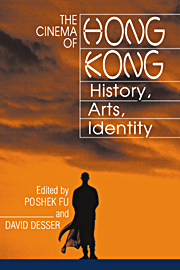Book contents
- Frontmatter
- Contents
- List of Contributors
- Acknowledgments
- Introduction
- Chronology of Hong Kong Cinema
- PART I HISTORY
- PART II ARTS
- 5 Richness through Imperfection: King Hu and the Glimpse
- 6 Space, Place, and Spectacle: The Crisis Cinema of John Woo
- 7 Besides Fists and Blood: Michael Hui and Cantonese Comedy
- 8 The Film Work of Ann Hui
- PART III IDENTITY
- Index
5 - Richness through Imperfection: King Hu and the Glimpse
Published online by Cambridge University Press: 05 June 2012
- Frontmatter
- Contents
- List of Contributors
- Acknowledgments
- Introduction
- Chronology of Hong Kong Cinema
- PART I HISTORY
- PART II ARTS
- 5 Richness through Imperfection: King Hu and the Glimpse
- 6 Space, Place, and Spectacle: The Crisis Cinema of John Woo
- 7 Besides Fists and Blood: Michael Hui and Cantonese Comedy
- 8 The Film Work of Ann Hui
- PART III IDENTITY
- Index
Summary
As one of Asia's finest directors, King Hu (Hu Jinquan) deserves study from many angles: his treatment of historical periods, his thematic preoccupations, his stratagems of plotting, his handling of character point of view. In what follows, I hope to clarify an aspect of his work over which he labored patiently – visual style. Working on Come Drink with Me (1965), he realized that “if the plots are simple, the stylistic delivery will be even richer.” Visual design was very important to him; he drew every shot in advance and supplied the cast and crew with photocopies. Declaring himself ignorant of the martial arts (“Kung fu, Shaolin tales – I don't understand anything about that”), he derived his combat techniques from Beijing opera and compared his fight scenes to dances. He lavished attention on his set-pieces, spending twentyfive days shooting the confrontation in the bamboo forest in A Touch of Zen (1970). Whatever his other preoccupations – Zen, China's history – Hu is an unabashed aesthete, and an aesthetic approach to his style seems natural.
Just as naturally, the most inviting objects of stylistic inquiry are his magnificent fight scenes. True, Hu might discourage critics from concentrating wholly on them. Legend of the Mountain (1979) and All the King's Men (1983) pointedly avoid the frenzied fights that made his reputation. He told one interviewer that The Fate of Lee Khan (1974) was initially conceived as a theatre-like piece centering on interweaving intrigues, but happily for us the distributors and exhibitors insisted on fights.
- Type
- Chapter
- Information
- The Cinema of Hong KongHistory, Arts, Identity, pp. 113 - 136Publisher: Cambridge University PressPrint publication year: 2000
- 4
- Cited by

